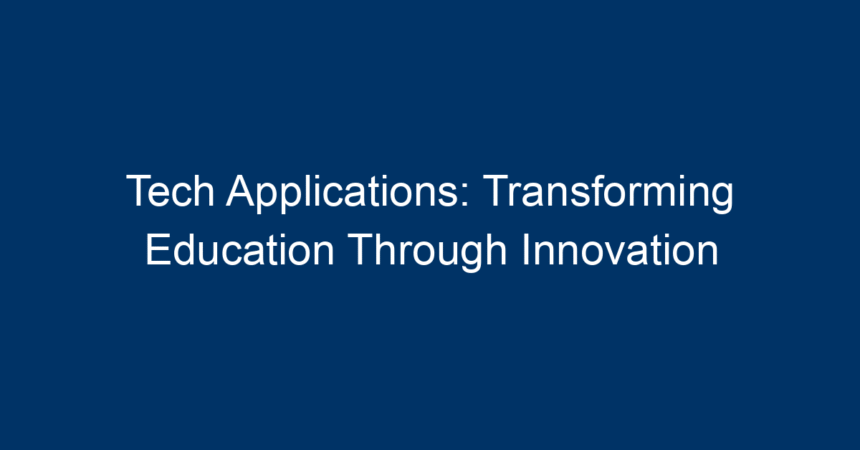In an era where technology permeates every aspect of our lives, the educational sector is not lagging behind. Tech applications are revolutionizing how we teach, how students learn, and how educational institutions operate. From online classrooms and Artificial Intelligence (AI) tutors to virtual reality (VR) simulations, technology is creating dynamic learning environments that cater to diverse needs and styles. This article delves into the transformative power of tech applications in education, their myriad benefits, and practical insights on harnessing this innovation.
The Role of Tech Applications in Education
Bridging Gaps in Learning
Traditional teaching methods often fail to address individual learning paces and styles. Tech applications are stepping in to fill this gap. Adaptive learning technologies use algorithms to tailor educational content, allowing students to progress at their own speed. Applications such as Khan Academy and Duolingo employ these methods, offering personalized learning pathways that meet individual needs.
Enhancing Engagement Through Gamification
Educational gamification integrates game-design elements into learning processes, making lessons more engaging. Platforms like Classcraft use interactive storytelling and rewards systems to motivate students. This not only captivates students’ attention but also fosters a more relaxed atmosphere conducive to learning. By incorporating tech applications that leverage gamified experiences, educators can spark creativity and curiosity in their classrooms.
The Rise of Online Learning Platforms
Expanding Accessibility and Flexibility
Online learning platforms such as Coursera, edX, and Udemy democratize education by providing affordable and accessible courses to anyone with an internet connection. This shift to digital learning enables students from different socio-economic backgrounds to access high-quality education, thus promoting equity in learning opportunities. The flexibility of online courses allows learners to study at their convenience, balancing education with personal responsibilities.
Collaborative Learning Experiences
Tech applications that facilitate collaboration are redefining group projects and peer learning. Tools like Google Classroom and Microsoft Teams offer features for real-time collaboration, enabling students to work together, share resources, and engage with their peers from anywhere. This fosters a sense of community and teamwork, essential skills for success in today’s workplace.
The Role of Artificial Intelligence in Education
Personalized Learning Experiences
AI-powered tools like IBM’s Watson and Carnegie Learning offer adaptive learning technologies that analyze students’ performance in real-time. By understanding individual weaknesses and strengths, these AI systems provide customized resources and recommendations, significantly enhancing the learning experience.
Automating Administrative Tasks
Beyond the classroom, AI tech applications streamline administrative tasks for educators. Automated grading systems and chatbots can handle routine inquiries, reducing the administrative workload on teachers and allowing them to focus more on instructional delivery. This increases overall productivity and enables educators to devote more time to innovative teaching practices.
Virtual and Augmented Reality: Immersive Learning
Transforming Lesson Delivery
Virtual Reality (VR) and Augmented Reality (AR) tech applications are pushing the boundaries of conventional education. Platforms like Google Expeditions allow students to take virtual field trips, transporting them to historical sites or distant ecosystems without leaving the classroom. Such immersive experiences can deepen understanding and retention of knowledge by making learning visually rich and interactive.
Enhancing Practical Skills Training
In fields such as medicine, engineering, and architecture, VR and AR applications provide realistic simulations that allow students to practice skills in a controlled environment. For example, medical students can perform surgeries in a virtual setting, reducing risks associated with traditional hands-on training. This innovation not only boosts confidence but also prepares students for real-world scenarios.
The Impact of Tech Applications on Educators
Professional Development and Continuous Learning
Incorporating tech applications doesn’t just benefit students; educators also stand to gain significantly. Online learning platforms offer professional development courses, enabling teachers to enhance their skills and incorporate new technologies into their teaching practices. Continuous learning fosters adaptability, which is crucial in an ever-evolving educational landscape.
Data-Driven Insights for Enhanced Teaching
Tech applications that compile and analyze data provide valuable insights into student performance. Educators can utilize tools like Edmodo or Canvas to track student progress and identify trends. By leveraging this data, teachers can adjust their methodologies and improve educational outcomes, ultimately leading to more effective teaching strategies.
Challenges in Implementing Tech Applications
Digital Divide and Accessibility Issues
Despite the promising potential of tech applications, challenges remain. The digital divide—disparity in access to technology—can hinder equitable learning opportunities. Students from underprivileged backgrounds may lack devices or stable internet access, creating educational inequities. Educational institutions and policymakers must work towards comprehensive solutions, ensuring everyone can benefit from tech innovations.
Training and Support for Educators
Not all educators are well-versed in using advanced tech applications. Professional development and continuous support are essential for successful implementation. Schools must invest in training programs to equip teachers with the necessary skills to use these tools effectively. Fostering a culture of collaboration and sharing best practices among educators can also enhance the integration of technology in classrooms.
Future Trends in Educational Technology
The Growth of Advanced Learning Analytics
As technology continues to evolve, learning analytics will play a critical role in shaping educational pathways. Advanced analytics will provide deeper insights into student engagement and retention, allowing educators to craft more personalized learning experiences.
Rise of Blockchain in Education
Blockchain technology promises to enhance the transparency and security of records in education. From verifying credentials to securely storing academic achievements, tech applications utilizing blockchain will streamline administrative processes and reduce fraud.
Conclusion: Harnessing Tech Applications for a Brighter Future in Education
Tech applications are no longer just a supplementary tool; they are essential in transforming education for the better. By embracing these innovations, educators can create more inclusive, engaging, and effective learning environments. From personalized learning experiences to immersive simulations and collaborative platforms, the possibilities are vast and exciting.
Actionable Insights
- Invest in Training: Ensure ongoing professional development for educators to keep pace with tech innovations.
- Leverage Data: Use analytics tools to inform teaching strategies and track student progress effectively.
- Promote Equity: Work towards initiatives that address the digital divide, ensuring all students have access to necessary technology.
- Explore New Technologies: Stay informed about emerging technologies such as VR, AR, and AI to continually enhance the educational experience.
Incorporating tech applications in education can inspire learners and create a more dynamic, responsive educational framework—one that prepares students not just for today, but for tomorrow.




